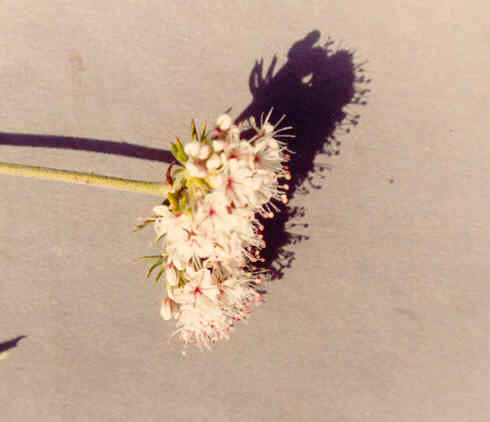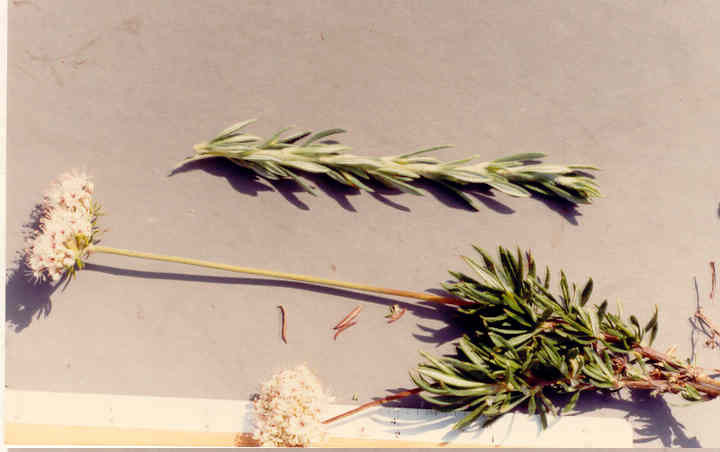
Eriogonum fasciculatum var. foliolosum (Nutt.) Stokes
 |
Eriogonum fasciculatum var. foliolosum (Nutt.) Stokes
Polygonaceae (Buckwheat Family)NativeCalifornia BuckwheatInterior Flat-Topped Buckwheat |
March Photo
Plant Characteristics:
Low spreading shrubs, the stems +/- decumbent, 6-12 dm. long, branched,
leafy; branchlets pubescent, ending in leafless peduncles 1-2 dm. long, bearing
+/- open cymose infl. with many capitate clusters at the tips; lvs. numerous,
fascicled, oblong-linear to linear-oblanceolate, green, pubescent above,
white-wooly beneath, 6-15 mm. long, strongly revolute; invols. prismatic, 3-4
mm. high, pubescent, with 5 short acute teeth; calyx white to pinkish, ca. 3 mm.
long, pubescent, the outer segms. broadly elliptic, the inner obovate; fils.
subglabrous basally; aks. lance-ovoid, shining, ca. 2 mm. long.
Very variable.
Habitat:
Common in interior cismontane slopes and mesas, below 3000 ft.; Coastal
Sage Scrub, Chaparral; n. L. Calif. to Monterey Co.
March-Oct.
Name: Greek, erion, wool, and gonu, joint or knee, the type of the genus E. tomentosum Michx., being hairy at the nodes. (Munz, Flora So. Calif. 677). See ssp. fasciculatum for meaning of this word. Latin, foliosus, full of leaves. (Jaeger 104).
General:
I do not know how prevalent var. foliolosum is.
E. fasciculatum is quite common but I have not had
the opportunity to study the frequency of each variety. The varieties look very
similar to the naked eye, the major difference in the two being that the upper
surface of the leaves, outer surface of the calyx and the involucres are
pubescent. (my
comments). The Cahuilla, Indians of the
Colorado Desert, the San Jacinto and San Bernardino Mountains, found Eriogonum
sp. especially abundant on foothill slopes, in dry sandy areas, and on
alpine meadows. A strong, black
decoction made from the leaves was drunk as a cure for headaches and stomach
disorders. The white flowers were
steeped to make an eyewash or a drink that was said to clean out the intestines.
Leaves growing near the root were used as a physic.
The oldest plants were said to be most efficacious as a medicine.
Edible shoots were available in the desert from February to May, while
the seeds, also eaten, were gathered from June until September. A tea was used for dull nagging pain in pregnancy,
especially in the back and hips. (Bean and Saubel 72). This
subspecies is one of the important bee plants of the foothills, mesas and lower
altitudes of the mountains of cismontane California from Monterey County to San
Diego and adjacent Lower California. (Abrams,
Vol. II 49).
This herbs mild astringency makes it useful as a gargle for sore throats
under any conditions. The tea was
also used for premenstrual water retention and the fluid retention that often
occurs in the last month or two of pregnancy.
(Moore, Medicinal Plants of the Desert and Canyon West
19). An important honey plant.
(Hickman, Ed. 872).
Text Ref:
Dale 157; Hickman, Ed. 872; Munz, Flora So. Calif. 685; Roberts
33.
Photo Ref:
Mar 3 85 # 14,15.
Identity: by R. De Ruff, confirmed by F. Roberts.
First Found: March 1985.
Computer Ref: Plant Data 347.
Have plant specimen.
Last edit 10/18/04.
 |
March Photo